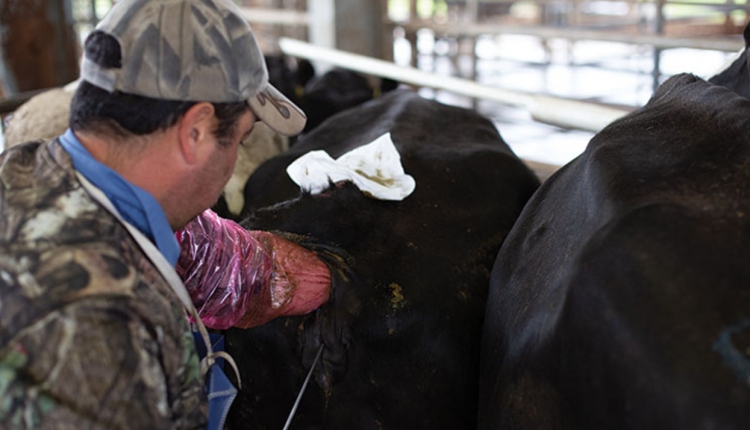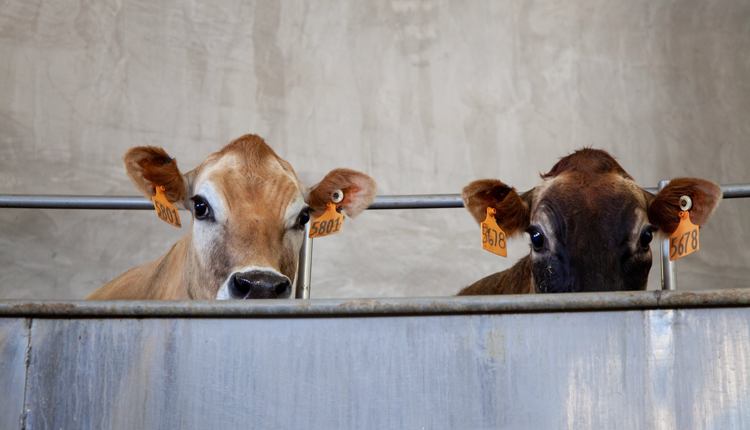The author is a professor and extension dairy specialist at the University of Idaho

Store liquid nitrogen semen tanks in a well-ventilated, clean, dry, and secure area to ensure personnel safety, promote long tank life, and deter theft. Securely fasten the tank during transportation to avoid tipping or damaging the tank, both of which will result in the premature loss of liquid nitrogen and sacrifice semen storage ability.
Keep a detailed inventory of semen that is easily accessible without looking into the storage tank, regardless of whether the tank is housed in an office or transported in a vehicle to a location closer to the cows to be serviced. This is so straws can be located and removed from the tank quickly to avoid exposure of semen to ambient temperature and to minimize loss of liquid nitrogen.
Mind the neck
When removing a straw from a liquid nitrogen semen storage tank, keep the canister, cane, and unused semen straws as low as possible in the neck of the tank. Keep in mind that although the temperature of liquid nitrogen is -320°F, there is a temperature gradient in the neck of the tank. For example, a tank with a neck tube that measures 6 inches long may have a temperature of -103°F in the middle of the neck (3 inches below the top), while the temperature at 1 inch below the top may be +5°F. A best management practice is to keep all unused straws below the frost-line in the neck of the tank.
A recent study at the University of Idaho provides evidence the temperature in the neck of a semen storage tank, especially in the area below the frost-line, exhibits wide variation and is influenced by liquid nitrogen level. Colorado State University researchers first reported the liquid nitrogen level in a tank can dramatically affect the temperature of straws repeatedly raised and lowered in the tank.
When a tank was full of liquid nitrogen, elevation of a cane, containing a goblet with five semen straws, into the neck of the tank for one minute resulted in straw temperature climbing 28 degrees (from -320°F to -292°F). However, it is important to recognize the increase in straw temperature was minimized as the goblet contained liquid nitrogen at the start of the exposure. The straw temperature returned to -320°F within 1 minute, even after five repetitions.
When the liquid nitrogen level in the tank was low (around 7 inches), the Colorado State University researchers reported the temperature of straws rose 131°F (from -320°F to -189°F) during the first minute, and straw temperatures cooled only 86°F to 104°F two minutes after returning to the tank. Consequently, higher temperatures were reached during the second, third, fourth, and fifth repetitions. Greater than 10 minutes were required for the straw temperature to reach -320°F upon return after the fifth repetition.
The ice pattern within bovine semen extender may change considerably (a process termed recrystallization) as it is warmed. Larger, extracellular ice crystals are associated with damage to sperm cell membranes and organelles, and previous reports have shown that sperm injury (as judged by sperm motility) occurs at temperatures as low as -110°F.
When Colorado State University researchers raised a 0.5-mL straw of semen into the neck of a tank using tweezers, the time necessary for the temperature to change from -320°F to -148°F was only 10 to 15 seconds. Therefore, to provide a margin of safety and avoid recrystallization injury to sperm in straws not removed from the same goblet or canister, the recommendation is for a cane (or canister containing canes) of frozen semen to be limited to eight seconds in the neck of a tank (below the frost-line) when retrieving straws.
Depending on the time required to remove a straw, other straws on the cane may be exposed to injurious high temperatures. Carelessly working above the frost line will likely be particularly damaging to sperm even when applying the “eight second rule,” as straw temperatures will rapidly enter the danger zone. Injury to sperm cannot be corrected by returning semen to the liquid nitrogen (-320°F); therefore, damage to sperm in straws not removed during improper retrieval of other straws is additive.
A simple measurement
In order to realize the return on your semen investment, the storage tank must be managed properly. Monitor the liquid nitrogen level regularly by placing a measuring stick in the tank. After reaching the bottom of the tank, wait four to five seconds, remove the stick, and allow frost to form on the measuring stick. The frost-line on the measuring stick represents the approximate level of liquid nitrogen in the tank.
A best practice is to never let the level of liquid nitrogen go below 10 inches. Failure to monitor the liquid nitrogen level in semen storage tanks, resulting in loss of semen, occurs too frequently. Replacement measuring sticks are available from a variety of suppliers. For more information on tank management, contact your A.I. stud representative or local university extension. Happy A.I. breeding!










